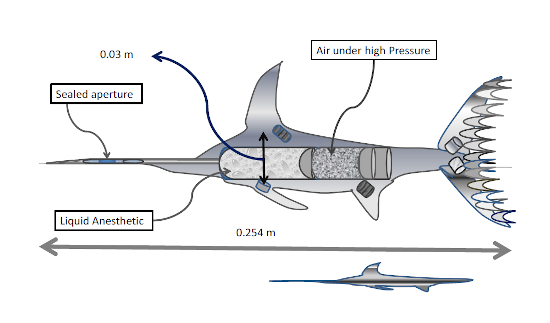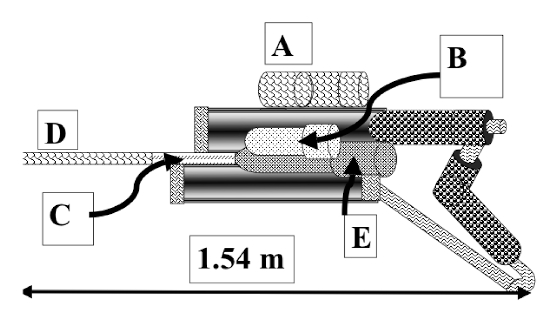Abstract
A dual-function or amphibious underwater dart rifle3 has been designed by the authors of this abstract. It is a double-barrel projector, with one barrel for launching tranquilizer darts and another barrel for launching net darts. In sub-aquatic environments, the rifle launches or projects tranquilizer darts, which are designed to mimic the anatomy and fluid dynamics of the sword fish (Xiphias gladius).10 The net dart has an outer shell made of pieces of glass tubing, which form a shell enclosing a net. Each segment of glass tubing is joined to the outer edge of the net. The barrels are 0.59 m in length and the length of the rifle is 1.54 m. The approximate weight is 9 kg. The darts are propelled by the energy released from the combustion of a stoichiometric mixture of hydrogen and oxygen in the firing chamber.8 Gas pressure in the firing chamber is amplified due to the presence of a blow pipe mouth piece at the exit aperture of the firing chamber.2-4
Introduction
Special operation units of the naval forces of the U.S. and Russia have been solving a military armament problem, which is shared with aquatic veterinarians around the world.3-7 The problem is the development of an amphibious rifle, which can be used under water and above the water surface, or on land in the medium of air.3-4 In the case of aquatic veterinary medicine it is the development of an amphibious dart rifle, which can be used in sub-aquatic environments and on land.6 This research team has adapted a multi-step experimental approach to solve the problem of developing an amphibious tranquilizing dart rifle. The rifle we are developing utilizes aerodynamic principles derived from the blow pipe used by the indigenous people of the Amazon.4-5
Materials and Methods
Aerodynamic and aerostatic studies conducted by the authors, have demonstrated that the Amazon blow pipes are governed by the major gas laws, Bernoulli’s Principle and Poiseuille’s Principle.1-2 The blow pipe barrel was examined and it was found to be a rigid tube in which there is a pressure differential due to the forced expiratory volume at one end, where the operator is introducing a large volume of air from her/his lungs into an extremely small space, the mouth-piece of the blow pipe. Ethnotoxicology studies were then conducted on artifacts of the blow pipe, including the darts and blow pipe barrel.5 Kinematic, bio-mimetic, and electrochemical thermodynamic studies were conducted on micro-rockets launched by the energy released from the combustion of hydrogen and oxygen.8 Utilizing the data from the hydrogen rocket studies, the aerodynamics studies, and the ethnotoxicology studies, an amphibious dart rifle has been developed by the authors, with double barrels and magazines for net darts and tranquilizing darts (Figure 1).9-10 The tranquilizing darts are dart syringes, encased in a plastic body, which mimic the morphology of the sword fish. In development is an optical system consisting of a regular underwater telescopic camera and a camera with night vision capabilities. The images from the scopes are relayed to 12 cm x 10 cm LCD screen attached to an optical loop and worn as a head gear (Sea Viewer Products, www.seaviewer.com). The image of the target animal can be viewed on the LCD screen, which can be used for aiming the rifle, when in use under water. A laser spotter on the rifle is used for precise location of targets.
Results
An amphibious dart rifle was developed. Figure 1 illustrates the components of the tranquilizing dart. Figure 2 is a diagram of the tranquilizing dart rifle without attachable gas propulsion units.
Figure 1

Sub-aquatic dart gun syringe, exploiting the fluid dynamical advantages of the sword fish
Figure 2

Amphibious dart rifle without the magazines: A. Housing for scope and periscope B. Adapter for the net dart barrel C. Compartment for insertion of tranquilizer dart magazine D. Barrel for tranquilizer dart E. Firing chamber
Conclusions
A stoichiometric ratio of two parts of hydrogen to one part of oxygen in the firing chamber of an amphibious tranquilizing dart gun provides energy for the expulsion of a dart at muzzle velocities equivalent to darts fired by conventional charges or air pressure.
Discussion
There is a need for detailed hydrodynamic and hydrostatic studies of the behavior of the underwater darts. Studies will be done to fully understand the motion of the darts under water and improve the function of the net darts. There is also a need to improve the optics of the rifle under water. An operator of the rifle should, with ergonomic ease, view targets through the lens of the diving goggles and remotely adjust the telescopes. The operator should also be able to switch from full spectrum or white light view to IR viewing.
Acknowledgments
This project has been funded by the Josh Weston Scholarship Program of Brooklyn Tech and the Brooklyn Tech Alumni Foundation. We are grateful for technical support from the Harvard University Herbarium where a part of the studies was conducted.
Literature Cited
1. Beerman RD, Allen JR. What is an air gun? In: Fjestad SP, ed. Blue Book of Air Guns. 5th ed. Minneapolis, MN: Blue Book Publications; 2005:38–57.
2. Crane D. Russian Amphibious Assault Rifle. Defense Review. www.defensereview.com. Accessed 2002.
3. Fedotov A, Yee M. How Do the Gas Laws Influence the Operation of the Blow Pipe? [abstract]. Villanova, PA: National Student Symposium of The National Consortium of Secondary Schools for Science Mathematics and Technology (NCSSSMST), Villa Nova University; 2005.
4. Edotov A, Yee M. The Development and Testing of a Pneumatic/Electromagnetic Dart Rifle [project report]. Siemen-Westing House Science Talent Search Competition; 2006.
5. Filatova N. A Study of the Commonality Between the Blow Pipes of the North Amazonian Tribes and the Use and Preparation of the Curare Poison [project report]. New City York Science and Engineering Fair; 2006.
6. Fowler ME. Chemical restraint. In: Restraint and Handling of Wild and Domestic Animals. Ames, IA: Iowa State University Press; 1995:36–56.
7. Jarvis JP. How the Russians Perfected Submerged Combat. www.freerepublic.com/focus/f-news. Accessed 2011. (VIN editor: Link was not accessible as of 11-10-20.)
8. Kuo E, Aponte C, Sasson D. The Development and Testing of a Solar Hydrogen Electric Aerosol Sampling Rocket Glider Plane [report]. New York City Science and Engineering Fair; 2011.
9. Lange CJ, Sakeeb K, Anika Z, et al. Solar hydrogen electric bio-mimetic energetics—a new and emerging sub-discipline of zoological medicine. Proceedings of the Annual Conference of the AAZV. 2009; Tulsa, OK.
10. Wyche A, Khan A, Boakye-Yeadom S. The Development and Testing of a Solar Hydrogen Electric Bio-Mechanical Portuguese Man-O-War [research paper]. Junior Stockholm Water Prize Competition; 2012:1–59.